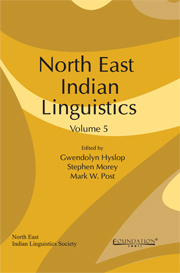Book contents
- Frontmatter
- Contents
- About the Contributors
- Foreword
- A Note from the Editors
- Contact and genetic linguistics
- Historical-comparative Tibeto-Burman grammar
- The North East Indian noun phrase
- Assamese grammar
- Advances in Boro-Garo phonology
- 11 Tiwa tones in monosyllables
- 12 The ‘sixth’ vowel in the Boro-Garo languages
- Poetics and text
12 - The ‘sixth’ vowel in the Boro-Garo languages
from Advances in Boro-Garo phonology
Published online by Cambridge University Press: 05 September 2013
- Frontmatter
- Contents
- About the Contributors
- Foreword
- A Note from the Editors
- Contact and genetic linguistics
- Historical-comparative Tibeto-Burman grammar
- The North East Indian noun phrase
- Assamese grammar
- Advances in Boro-Garo phonology
- 11 Tiwa tones in monosyllables
- 12 The ‘sixth’ vowel in the Boro-Garo languages
- Poetics and text
Summary
Background
The Boro-Garo languages form an unusually well-defined subgroup within the Tibeto-Burman family. At one time or another I have listened to a good many of these languages, some a half-century ago and for no more than a single session of elicitation, others more recently and with great care. My memory is hardly sharp for all of these languages, but in the course of this listening I have been struck by the frequency with which the languages of this group have exactly six simple monophthongs. (They all have a number of diphthongs as well, but I will have nothing to say about them in this paper).
Five of the monophthongs seem always to be the vowels that are most widespread in the languages of the world, those easily written as i, e, a, o and u. It is clear, moreover, that in most, perhaps all, Boro-Garo languages, these five vowels are mutual cognates and reconstructable to five vowels in ancestral Boro-Garo (Joseph and Burling 2006). The simplicity of these vowel systems is striking when contrasted with the vowel systems of many other Tibeto-Burman languages, both in North East India and elsewhere. Many of these other languages have more vowels, and more varied vowels, than do the languages of the Boro-Garo sub-group.
In addition to these five familiar monophthongs, however, most Boro-Garo languages also have a sixth vowel, one that has quite a different character, and one that is more variable from one language to another than any of the familiar five.
- Type
- Chapter
- Information
- North East Indian Linguistics , pp. 271 - 280Publisher: Foundation BooksPrint publication year: 2013
- 1
- Cited by



